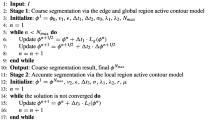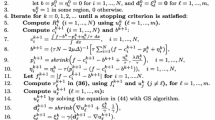Abstract
In this paper, we propose a novel model for image segmentation by using the Cahn–Hilliard equation. An interesting feature of this model lies in its ability of interpolating missing contours along wide gaps in order to form meaningful object boundaries, which is often achieved by curvature dependent models in the literature. To solve the associated equation, we employ a recently developed technique, that is, the tailored-finite-point method, which helps preserve sharp jumps and thus helps locate segmentation contours more exactly. Numerical experiments are presented to demonstrate the effectiveness of the proposed model and its features. In addition, analytical results on the existence and uniqueness of the associated equation are also provided.








Similar content being viewed by others
References
Bae, E., Tai, X.C., Zhu, W.: Augmented lagrangian method for an Euler’s elastica based segmentation model that promotes convex contours. Inverse Probl. Imaging 11(1), 1–23 (2017)
Bertozzi, A., Esedo\(\bar{\rm g}\)lu, S., Gillette, A.: Analysis of a two-scale Cahn–Hilliard model for binary image inpainting. Multiscale Model. Simul. 6(3), 913–936 (2007)
Caselles, V., Kimmel, R., Sapiro, G.: Geodesic active contours. Int. J. Comput. Vis. 22(1), 61–79 (1997)
Chan, T.F., Vese, L.A.: Active contours without edges. IEEE Trans. Image Process. 10(2), 266–277 (2001)
Chen, Y., Tagare, H.D., Thiruvenkadam, S.: Using prior shapes in geometric active contours in a variational framework. Int. J. Comput. Vis. 50(3), 315–328 (2002)
Cherfils, L., Fakih, H., Miranville, A.: A complex version of the Cahn–Hilliard equation for grayscale image inpainting. Multiscale Model. Simul. 15(1), 575–605 (2017)
Han, H., Huang, Z., Kellogg, R.B.: A tailored finite point method for a singular perturbation problem on an unbounded domain. J. Sci. Comput. 36(2), 243–261 (2008)
Huang, Z., Li, Y.: Monotone finite point method foe non-equilibrium radiation diffusion equations. BIT Numer. Math. 56(2), 659–679 (2016)
Kass, M., Witkin, A., Terzopoulos, D.: Snakes: active contour models. Int. J Comput. Vis. 1(4), 321–331 (1988)
Mumford, D., Shah, J.: Optimal approximations by piecewise smooth functions and associated variational problems. Commun. Pure Appl. Math. 42(5), 577–685 (1989)
Nitzberg, M., Mumford, D., Shiota, T.: Filtering, segmentation and depth. Lecture Notes in Computer Science. Springer (1993)
Osher, S., Sethian, J.A.: Fronts propagating with curvature-dependent speed: algorithms based on Hamilton–Jacobi formulations. J. Comput. Phys. 79(1), 12–49 (1988)
Rudin, L.I., Osher, S., Fatemi, E.: Nonlinear total variation based noise removal algorithms. Physica D 60(1–4), 259–268 (1992)
Shen, J., Kang, S.H., Chan, T.F.: Euler’s elastica and curvature-based inpainting. SIAM J. Appl. Math. 63(2), 564–592 (2003)
Tai, X.C., Hahn, J., Chung, G.J.: A fast algorithm for Euler’s elastica model using augmented Lagrangian method. SIAM J. Imaging Sci. 4(1), 313–344 (2011)
Taylor, J.E., Cahn, J.W.: Linking anisotropic sharp and diffuse surface motion laws via gradient flows. J. Stat. Phys. 77(1), 183–197 (1994)
Vese, L.A., Chan, T.F.: A multiphase level set framework for image segmentation using the Mumford and Shah model. Int. J. Comput. Vis. 50(3), 271–293 (2002)
Yang, W., Huang, Z., Zhu, W.: An efficient tailored finite point method for Rician denoising and deblurring. Commun. Comput. Phys. 24(4), 1169–1195 (2018)
Zhu, W., Tai, X.C., Chan, T.: Image segmentation using Euler’s elastica as the regularization. J. Sci. Comput. 57(2), 414–438 (2013)
Author information
Authors and Affiliations
Corresponding author
Additional information
Publisher's Note
Springer Nature remains neutral with regard to jurisdictional claims in published maps and institutional affiliations.
This work was partially supported by National Key Research and Development Program of China 2017YFC0601801 and NSFC Project No. 11871298.
Rights and permissions
About this article
Cite this article
Yang, W., Huang, Z. & Zhu, W. Image Segmentation Using the Cahn–Hilliard Equation. J Sci Comput 79, 1057–1077 (2019). https://doi.org/10.1007/s10915-018-00899-7
Received:
Revised:
Accepted:
Published:
Issue Date:
DOI: https://doi.org/10.1007/s10915-018-00899-7




